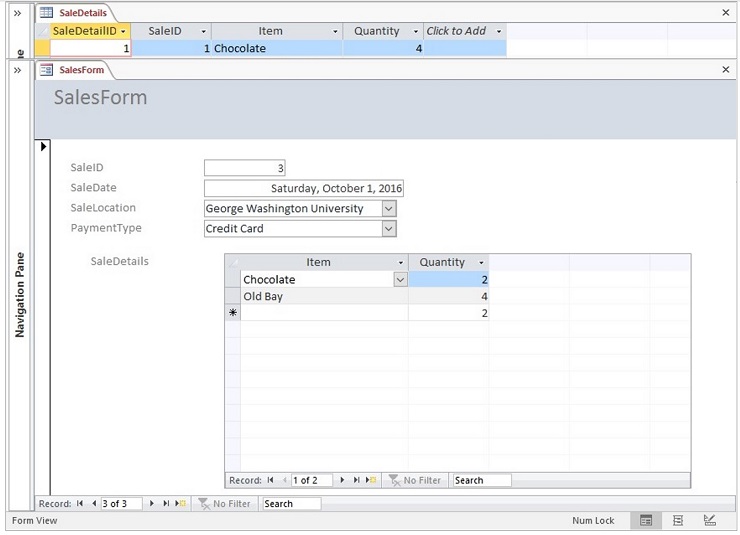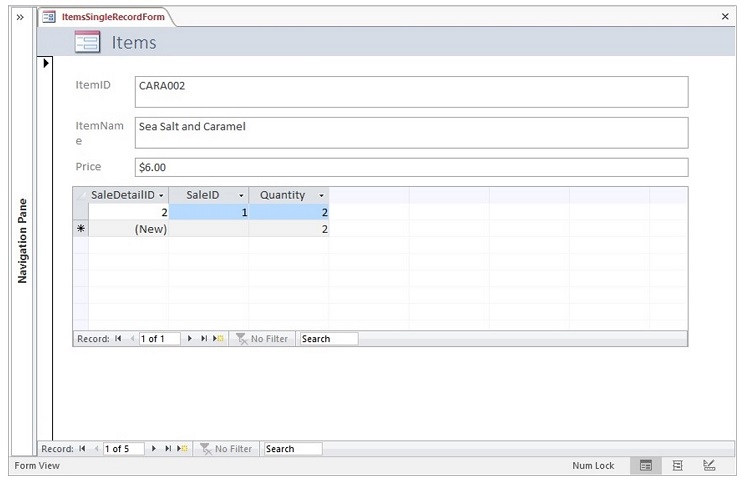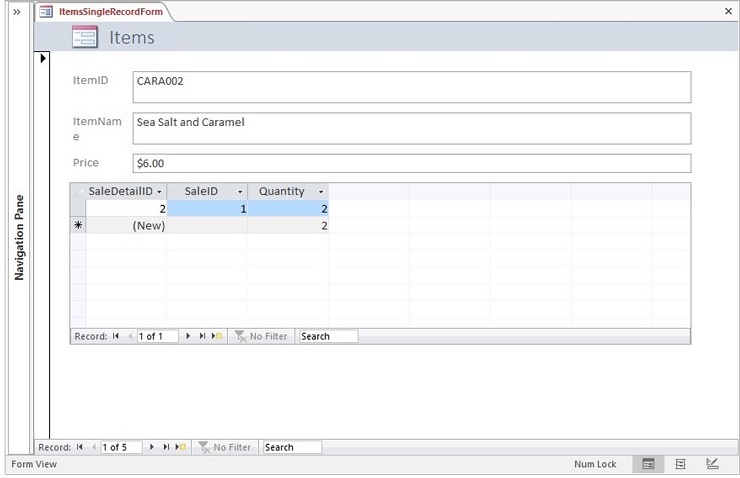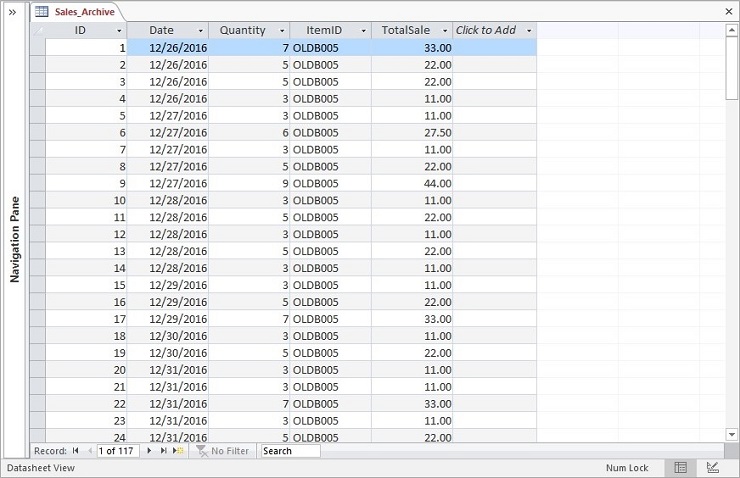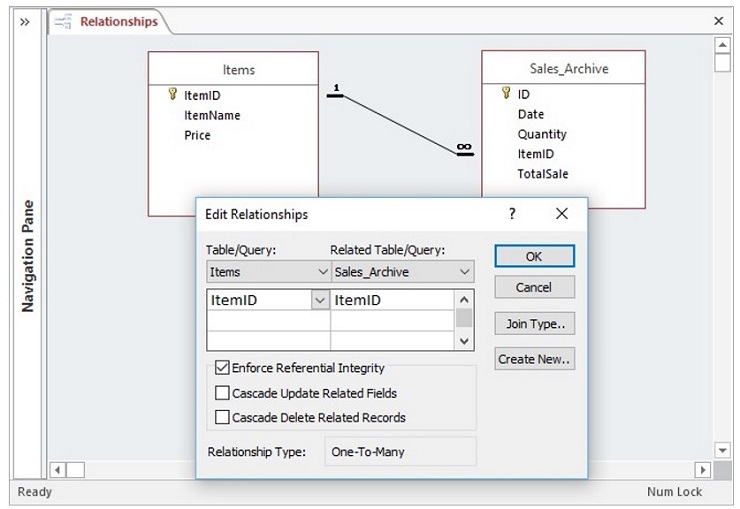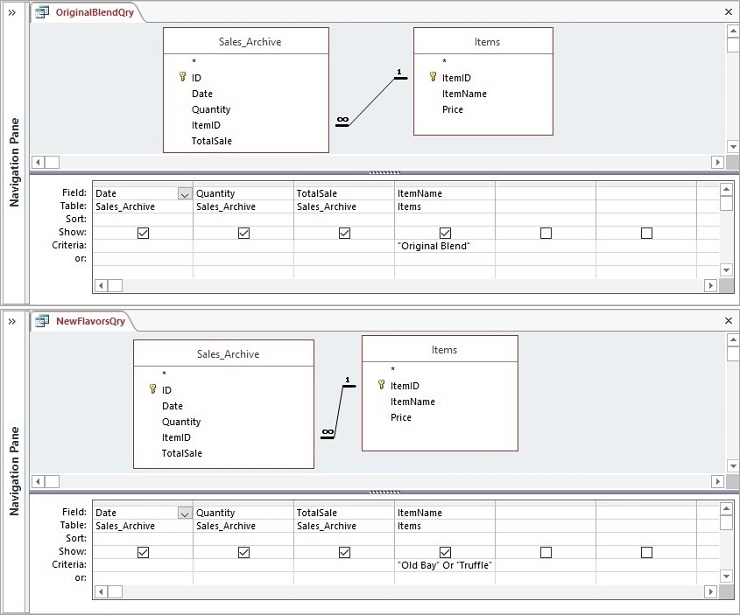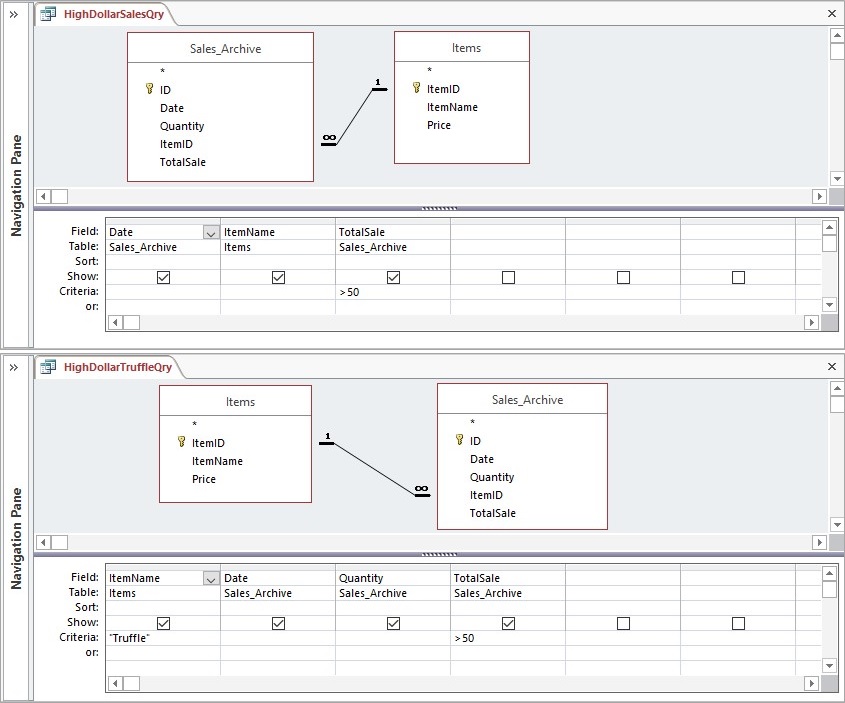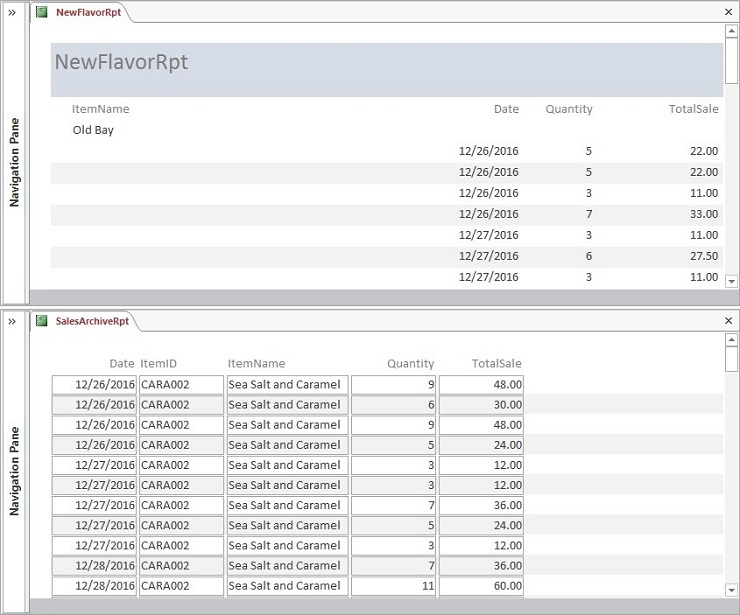AC2019 Capstone Level 2 Working with a Sales Database
Skills needed to complete this project:
- Create and save a new table
- Add a new field to a table
- Create a lookup field using values from another table
- Apply date formatting to a field by modifying the field Format property
- Create a lookup field using list values
- Create a new record in a table
- Adjust table column widths
- Set a default value for a field in a table
- Use the Form Wizard to create a new form
- Change the data type of a field
- Create a Single Record form based on a table
- Create a new blank form in Layout view
- Add fields to a blank form from Layout view
- Resize controls in a form
- Move controls in a form
- Delete a field from a table
- Delete a record from a table
- Find and replace data in a table
- Rename a field in a table
- Create a one-to-many relationship between two tables
- Enforce referential integrity in a one-to-many relationship
- Create a simple select query to combine fields from multiple tables
- Add text criteria to a query
- Hide a field in a query
- Use OR in a query
- Add numeric criteria to a query
- Use AND in a query
- Use the Report Wizard to create a new report
- Create a new blank report
- Add fields to a blank report from Layout view
- Resize controls in a report
- Arrange controls in a report
- Open the start file AC2019-Capstone-Level2.
NOTE: If necessary, enable active content by clicking the Enable Content button in the Message Bar.
- The file will be renamed automatically to include your name. Change the project file name if directed to do so by your instructor, and save
- Create a new table from scratch to track sales.
- The first field should be an AutoNumber field named: SaleID
- The second field should be a Date & Time field named: SaleDate
- The third field should be a lookup field. (Hint: Use the Lookup Wizard to create the new field.) It should display the LocationDescription field from the Locations table. Values in the lookup should be sorted by values in the LocationDescription field. Include the LocationID field in the lookup, but do not display it. (Hint: Hide the key column.) Enable data integrity by restricting deletions. Name this field: SaleLocation
- Save the table with the name: Sales
- Switch to Design view and modify field properties.
- Apply the Long Date format to the SaleDate
- Add a new lookup field as the last field in the Sales table to track payment type. (Hint:
Use the Lookup Wizard to create the new field.)
- Name the field: PaymentType
- The lookup field should display these values in this order:
Cash
Credit Card
Gift Card
Store Credit
- Limit data entry to values in the list. Do not allow multiple values.
- Save the table.
- Switch back to Datasheet view to add sample records to the Sales
- Add three records to the table with the following data. (Hint: Remember, the first
field in the table, SaleID, is an AutoNumber field, so there is nothing to enter for each record.)
| SaleDate | SaleLocation | PaymentType |
| 10/01/2019 | Georgetown | Cash |
| 10/1/2019 | Farragut Square | Gift Card |
| 10/1/2019 | George Washington University | Credit Card |
- Adjust the width of the SaleDate field so the entire long date is visible.
- Save and close the table.
- Create a new table to capture the details for each sale.
- The first field should be an AutoNumber field named: SaleDetailID
- The second field should be a lookup field named: SaleID The lookup field should be limited to values in the SaleID field of the Sales Include only the SaleID in the lookup field. Enable data integrity by restricting deletions.
- Save the table as: SaleDetails
- Add a third field to the far right of the table. Name this field: Item This is another lookup field. Include all the fields from the Items Sort the lookup items by values in the ItemName field. Hide the primary key field. Enable data integrity by restricting deletions.
- Add a Number field to the right of the Item Name the field: Quantity
- Set the default value for the Quantity field to: 1
- Add three records to the table with the following data. (Hint: Remember, the first field in the table, SaleDetailID, is an AutoNumber field, so there is nothing to enter for each record.)
SaleID Item Quantity 1 Chocolate 4 1 Sea Salt and Caramel 2 2 Truffle 3 - Close the table.
- Use the Form Wizard to create a new form for inputting sales data.
- Include all the fields from the Sales
- Include the Item and Quantity fields from the SaleDetails
- View the form data by records in the Sales table with related records in the SaleDetails table displayed in a subform.
- The subform should be displayed as a Datasheet.
- Name the main form: SalesForm and name the subform: SaleDetailsSubform (Hint: Be sure to remove the space between SaleDetails and Subform in the subform name suggested by Access.)
- Open the form in Form view to review your work.
- Navigate to the record in the main form for SaleID 3 and enter sale details in the subform as follows:
Item: Chocolate, Quantity: 2
Item: Old Bay, Quantity: 4
- Close the form.
- Open the Items table and modify the table fields as follows:
- Set the Default Value property for the Price field to: 7
- Change the data type for the Price field to: Currency
- Autofit the width of the ItemName
- Save the changes and close the Items
- Create a Single Record form using the Items table as the record source. Save the form with the name: SingleRecordForm
- Begin a new blank form in Layout view.
- From the Locations table, add the LocationID,
LocationDescription, and Comments fields in that order, at the left side of the form.
- Widen the labels so that they are just wide enough for LocationDescription to be completely visible.
- From the Locations table, add the OpenTime field to the right of
the LocationID controls.
- Reduce the width of the OpenTime bound control so that the control is just wide enough to display the time data.
- From the Locations table, add the CloseTime field to the right of
the OpenTime controls.
- Reduce the width of the CloseTime bound control so the control is just wide
enough to display the time data.
- Move the OpenTime and CloseTime controls so they are next to
the LocationDescription controls instead.
- From the Locations table, add the Days field to the form layout in the empty space to the right of the LocationID controls, above the OpenTime
- Add a logo to the form header. Use this file, located with the resources for this
project: toptCornLogo-small.png
- Save the form with the name: LocationsDetailsForm
- Close the forms.
- Open the SalesArchive
- Delete the Total
- Find the record with the ID 500 and delete it. (Hint: It is the last record in the table.) c. Find and replace each ItemID value OLDB with OLDB005.
- Rename the TotalSal field to: TotalSale
- Save and close the table.
- Use the Relationships window to create a relationship between the Items and SalesArchive
- Show the SalesArchive table in the Relationships window.
- Create a one-to-many relationship between the ItemID field in the Items table and the ItemID field in the SalesArchive You may rearrange the tables in the Relationships window if you want.
- Enforce referential integrity so a record cannot be deleted or altered in the Items table if it would cause a conflict with the data in the SalesArchive
- Close the Relationships window and save the changes.
- Create a query to display sales of Truffle flavored popcorn from the SalesArchive
- Include the following fields in this order: the SaleDate, Quantity, and TotalSale fields from the SalesArchive table and the ItemName field from the Items
- Add the criteria Original Blend to the ItemName Run the query to check your work. (Hint: There should be 34 records in the query results.)
- Save the query as OriginalBlendQry and then close the query.
- Create a query to display sales of Old Bay or Truffle flavored popcorn from the SalesArchive table
- Include the following fields in this order: the SaleDate, Quantity, and TotalSale fields from the SalesArchive table and the ItemName field from the Items
- Add the criteria Old Bay or Truffle to the ItemName Run the query to check your work. (Hint: There should be 55 records in the query results.)
- Save the query as NewFlavorsQry and then close the query.
- Create a query to display sales for more than $50.00 from the SalesArchive
- Include the following fields in this order: the SaleDate from the SalesArchive table, ItemName field from the Items table, and TotalSale from the SalesArchive
- Add criteria to the TotalSale field to return only sales greater than 50.
- Specify the sort order in the query, so the results always display the records with
the highest values in the TotalSale field first. Run the query to check your work.
(Hint: There should be 14 records in the query results.)
- Save the query as HighDollarSalesQry and close it.
- Create a query to display sales for more than $50 of Truffle flavored popcorn from the SalesArchive table
- Include the following fields in this order: the ItemName field from the Items table and the SaleDate, Quantity, and TotalSale fields from the SalesArchive
- Add the criteria to the query to return only records where the ItemName is
- Include the following fields in this order: the ItemName field from the Items table and the SaleDate, Quantity, and TotalSale fields from the SalesArchive
Truffle and the TotalSale is greater than 50. Run the query to check your work.
(Hint: There should be 6 records in the query results.)
- Save the query as HighDollarTruffleQry and then close the query.
- Use the Report Wizard to create a report based on the NewFlavorsQry
- Include the fields from the NewFlavorsQry query in this order: ItemName, SaleDate, Quantity, and TotalSale.
- View the data by the Items
- Do not add any additional grouping.
- Sort the detail records by sale date.
- Use the Stepped layout in Portrait orientation.
- Name the report NewFlavorRpt and then view the report to check your work.
- Create a new report from scratch in Layout view.
- From the SalesArchive table, add the SaleDate field to the report. Add these fields in order to the right of the SaleDate controls: ItemName from the Items table, and Quantity and TotalSale from the SalesArchive
- Resize the ItemName controls so all the item names are visible. (Hint: Widen the ItemName column so the entire Sea Salt and Caramel name is visible.)
- Add the ItemID field from the Items Move the ItemID controls so they appear to the left of the ItemName controls.
- Save the report as: SalesArchiveRpt
- Save and close any open database objects and then close the database.
- Upload and save your project file.
Answers

